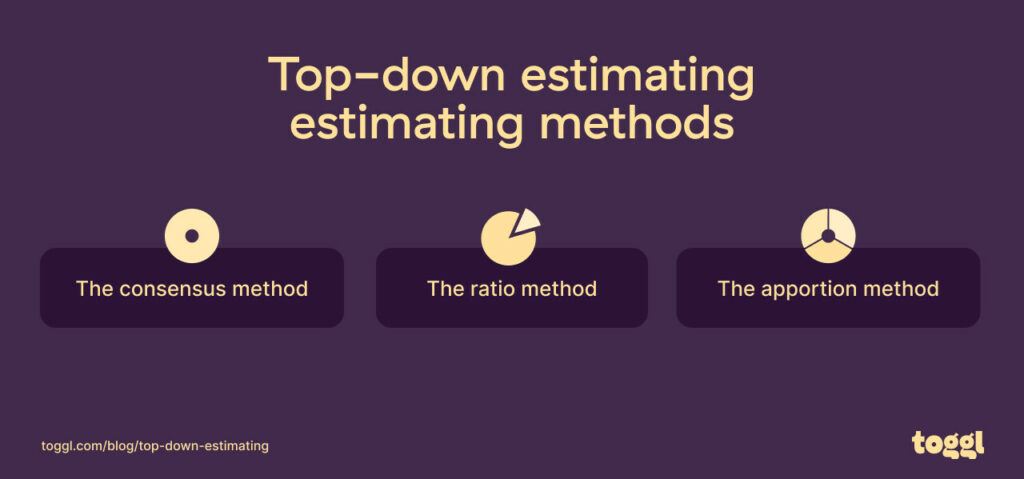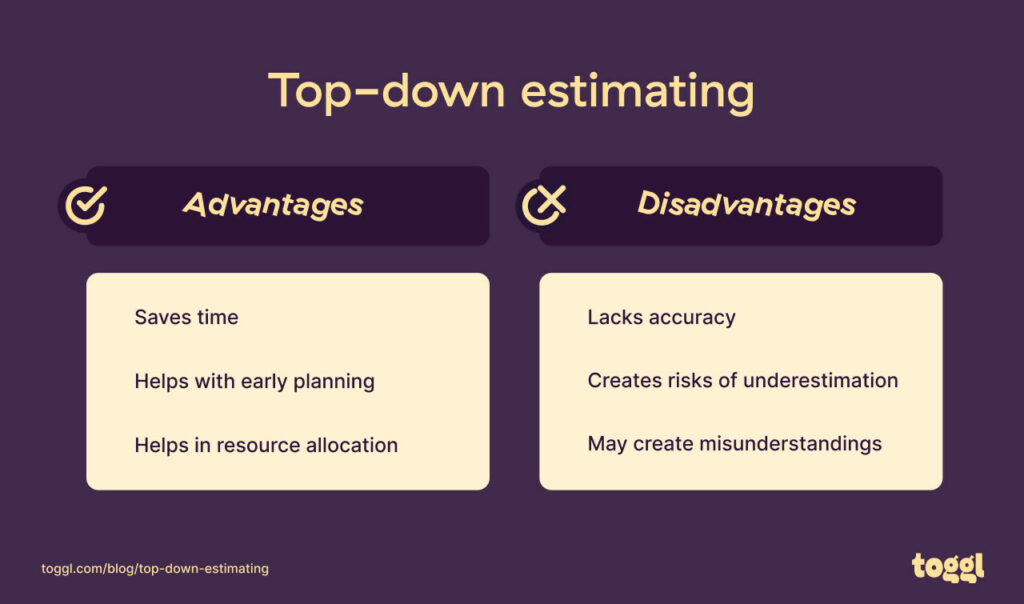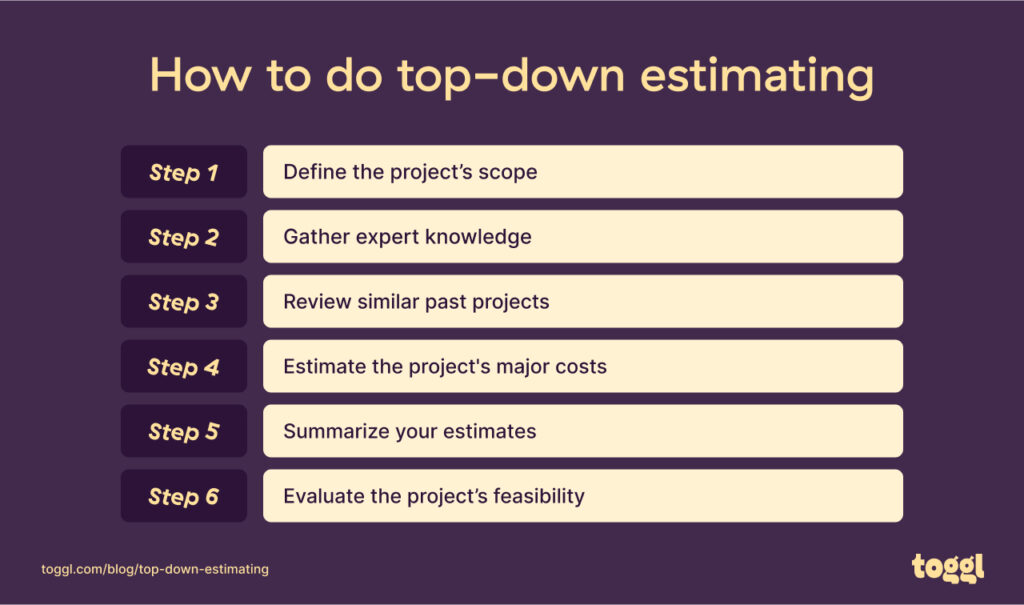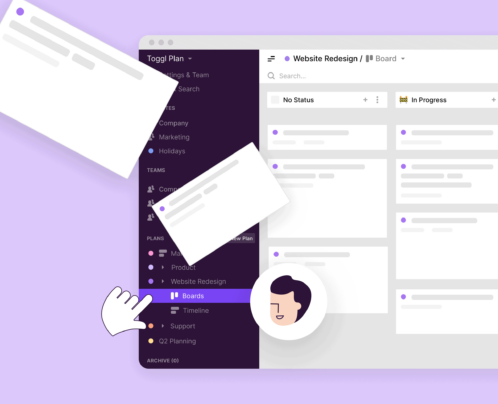Top-down estimating is a form of estimation where existing knowledge of similar projects is used in the estimation process to produce a ballpark figure for the total cost.
Like other methods to estimate a new project’s cost, top-down estimation has advantages and disadvantages.
We’ll discuss all of them in this article, plus:
- Examples of the top-down estimating technique
- Key steps for doing top-down estimating right
- Tips for making your estimates more accurate
Shall we start?
What is top-down estimating?
Top-down estimating gives you a high-level, rough estimate for your project.
It starts with an overall project view and breaks it down into smaller pieces.
Top-down estimating relies on historical data and input from experienced team members to develop project estimates.
This estimating method is best used for a quick estimation of the project costs rather than highly accurate forecasts.
Who uses top-down estimating?
Project managers use top-down estimation to get a high-level cost view.
However, they need input from teams closer to project details to improve accuracy.
Why?
That’s because managers don’t always have all the nitty-gritty details of specific projects, tools, or costs.
This knowledge comes from working directly on project specifics and can be very beneficial for estimating accurately.
Here are five steps that a top-down estimating process can include:
- Step 1: Managers analyze the project and its objectives.
- Step 2: They decide on a cost estimate based on similar past projects and their expertise.
- Step 3: They then share this estimated cost with their stakeholders, who provide feedback.
- Step 4: Following this feedback, individual teams go deeper and offer even more precise estimates of specific costs.
- Step 5: With all this input, managers can build an accurate project proposal.
An example of top-down estimating
Let’s give a specific example of how top-down estimating works for a marketing agency.
After receiving a project request for launching a social media campaign for a product, the agency’s leadership quickly outlines the campaign’s main components:
- Ad creation
- Content development
- Influencer partnerships
Using past campaign data and industry benchmarks, they estimate the overall budget for the project.
Middle managers then provide feedback, and individual teams break down costs for specific tasks like ad placements and influencer fees.
Company leaders consolidate the detailed estimates into a comprehensive budget proposal they present to the client. And voila!
Different top-down estimating methods
Here are three top-down estimating methods you should know about:

The consensus method
The consensus method prioritizes accuracy when estimating.
You can provide a more balanced estimate by gathering input from multiple stakeholders and agreeing on an estimate.
The ratio method
This method uses key project features and data from past projects to estimate current ones.
Company managers use ratios, like cost per square foot or cost per unit, to estimate the cost of a project compared to a similar project.
The apportion method
The apportion technique breaks down the cost of a project in a lot of detail.
For a marketing campaign, that could mean assigning 20% of the total project cost to ad creation, 30% to media buying, and 50% to labor and other expenses.
By dividing the budget like this, you know exactly how and where money is spent.
Top-down vs bottom-up estimating
Top-down and bottom-up estimating are two contrasting techniques.
The top-down approach starts with a high-level view of the project. It relies on data from past projects and input from experienced team members.
Top-down estimates are quick and helpful for initial budget planning but may lack precision.
On the other hand, the bottom-up approach breaks down tasks and resources to create a comprehensive estimate. This method is more accurate but time-consuming.
Top-down estimating works for:
- Quick initial estimates
- High-level budgeting
- Early project stages
Bottom-up estimating is a good fit for:
- Detailed and accurate estimates
- Complex projects with many components
- Projects where historical data is unavailable or insufficient
Advantages and disadvantages of top-down estimating
Top-down estimating comes with advantages and disadvantages. Here are some of both.

Advantages
- Saves time: Top-down estimating means you don’t have to worry about getting into details. It’s a quick and useful method to speed things up and work against tight deadlines.
- Helps with early planning: Top-down estimating helps you set initial budgets and spot potential feasibility issues before getting into detailed project planning.
- Helps in resource allocation: With top-down estimating, you can allocate resources more efficiently as you look at major project components and needs.
Disadvantages
- Lacks accuracy: The downside of being a quick method of estimating is that it lacks accuracy. Top-down estimates mostly rely on assumptions and often overlook specific project details.
- Creates risks of underestimation: When you use limited information to create an estimate, you risk underestimating costs and exceeding budgets.
- May create misunderstandings: Since top-down estimates are often inaccurate, they can cause client misunderstandings. For example, let’s say the actual costs for a project are way off from your initial estimate. They are not going to be happy about it.
How to do top-down estimating
While each company may have its own personalized top-down estimating process, these steps serve as a good foundation.

Step #1: Define the project’s scope
What are the overall goals of the project?
Thinking of deliverables and key objectives will help you define the broad parameters of your project. With this information, you can get an idea of the general costs of the project.
Step #2: Gather expert knowledge
Talk to experienced team members who have worked on similar projects to get more precise with your estimates.
Their input will get you closer to the project’s actual costs, including any potential risks or expenses you might have overlooked.
Step #3: Review similar past projects
Analyzing information from similar projects can help you create quick, data-based cost estimates.
With a feature like Toggl Track’s Project Dashboard, that’s super easy.
To access the Project Dashboard, log in to your Toggl Track account and go to Projects on the left sidebar.

There, you’ll see your project’s time, costs, and an automated forecast to get a clear picture of the project’s performance.

With these insights, you get even closer to nailing your top-down estimate.
Step #4: Estimate the project’s major costs
Using all this knowledge you’ve gained, it’s time to make general cost estimates.
What are the major expenses of your project?
Labor, materials, equipment, etc. Put a price on them without focusing too much on precision, as this is just a rough estimate.
Step #5: Summarize your estimates
Once you’ve estimated your major costs, put them all together so you get your estimation of the total cost of your project.
Step #6: Evaluate the project’s feasibility
The last step is to decide if your project is feasible.
Does your top-down estimate align with the available budget? Does the project look profitable?
If yes, you should continue with a more detailed cost estimate and start working on your project.
How to improve the accuracy of top-down estimates
Although top-down estimates give you a broad picture of your project’s costs, there are ways to make them more accurate.
Here are some ideas.
Be extremely picky when selecting comparable projects
Make your list of similar projects very accurate.
For example, if you’re estimating for a social media marketing campaign, don’t select an email marketing campaign project for comparison.
These two projects have different scopes, requirements, and expenses; comparing them won’t help your estimate.
Less is more when selecting comparable projects. It’s better to have three similar comparison projects than a more extensive list with less similar projects.
Refine your estimates during the project’s cycle
Keep your estimates flexible and open to change.
You’ll gather more information as you advance during your project’s life cycle. So, you need to refine your estimates if required.
For example, if a specific task requires more time than planned, be ready to change your estimate based on this new information.
Create an estimation process
Everything works better when you have a system in place for it.
Your top-down estimates will become more accurate if you create a process for each task discussed above.
For example, when picking similar projects, build a system that includes:
- Defining relevant criteria (size, scope, type)
- Using tools to analyze data and identify patterns
This system will help you create a list of relevant projects that you can use to create more accurate estimates.
Better estimates with the right software
Top-down estimating might work for some projects, and for others, it may not.
But with the right software, your estimates will surely be more accurate.
You can use Toggl Track to gather historical data and create more accurate estimates. Try Toggl Track for free and see for yourself!
Work tools to elevate your productivity – apps for incredibly simple time tracking and effective project planning.


